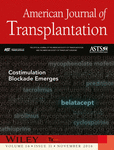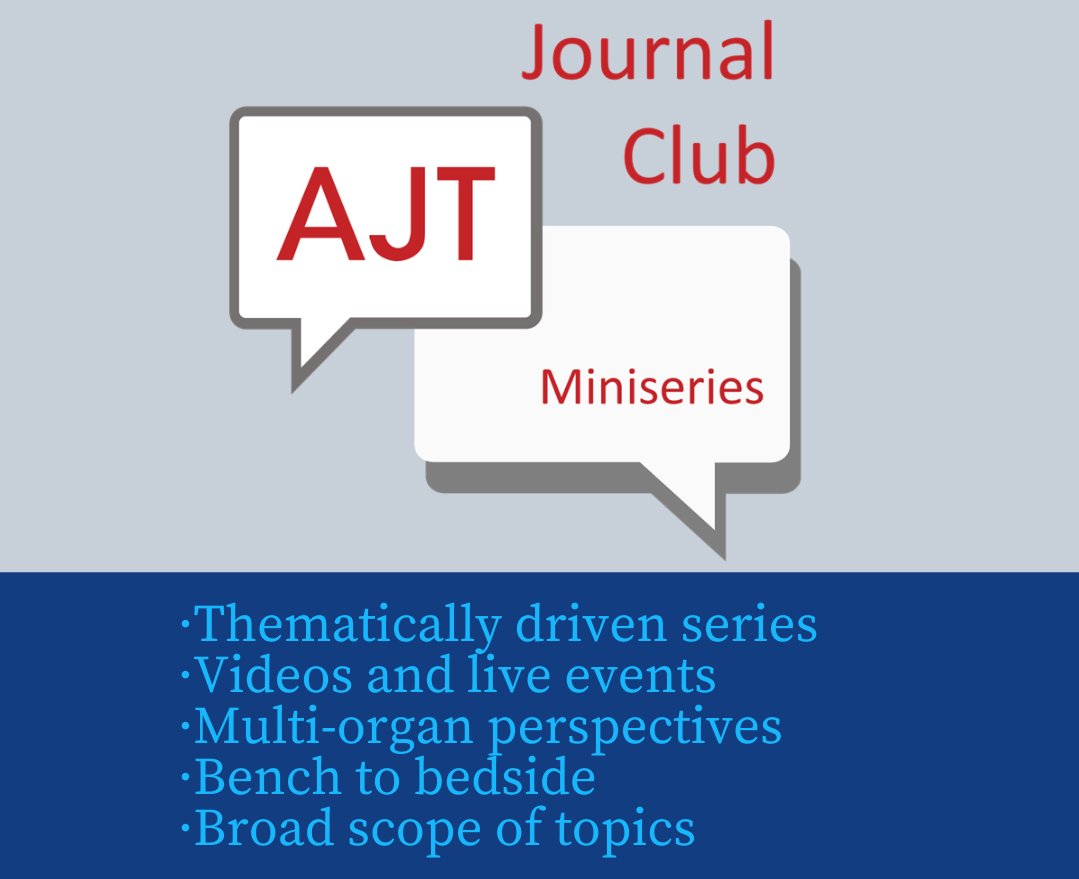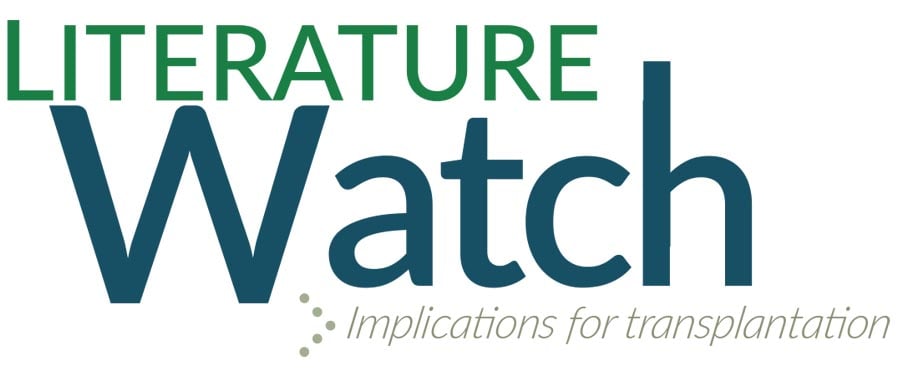Journal list menu
Export Citations
Download PDFs
Cover Image
American Journal of Transplantation: Volume 16, Number 11, November 2016
- First Published: 27 October 2016
On the cover this month: In 2011, belatacept was approved for use in kidney transplantation. Though its uptake by the transplant community has been gradual, owing at least in part to the many new mechanistic and logistical paradigms associated with its use, it is gaining a foothold in clinical practice. This month we feature several articles relevant to the growing use and acceptance of belatacept in clinical transplantation, including the final results of the pivotal BENEFIT-EXT study (Durrbach et al, page 3192), a registry analysis of postapproval use of belatacept (Wen et al, page 3202), and two articles describing expanded clinical use of belatacept. Ebcioglu et al (page 3278) describe belatacept use in an HIV-positive patient, and Krezdorn et al (page 3305) report on the use of belatacept in face transplantation. Also this month, we present the “What's Hot, What's New” summary of the 2016 American Transplant Congress (Levitsky and Gill, page 3105), and an overview article from the ASTS Scientific Studies Committee (Fayek et al, page 3093) with a useful summary of the SRTR data on liver transplantation. Cover design by Lauren Halligan, Duke University Department of Surgery.
The AJT Report
Stem Cell Derived Beta Cells: The State of the Science
- Pages: 3067-3068
- First Published: 27 October 2016
This issue's edition of “The AJT Report” covers highlights from the International Pancreas and Islet Transplant Association Key Opinion Leaders Meeting on Stem Cell Derived Beta Cells, held in September in Boston.
Literature Watch
B Cells Gasping for Air
- Page: 3069
- First Published: 27 October 2016
Cho and colleagues explore the impact of pO2 levels on germinal center B cell responses and demonstrate that sensing oxygen deprivation results in hypoxia-induced factor-dependent reduction of high affinity IgG class-switched responses.
Editorials
Phenotypes of Chronic Lung Allograft Dysfunction: Getting Closer Step by Step?
- Pages: 3071-3072
- First Published: 15 June 2016
The authors address current limitations of phenotyping chronic lung allograft dysfunction and stress the need for uniform diagnostic criteria, including an important role for imaging. See Suhling et al's article (page 3163).
The Trouble With Exceptional Exceptions
- Pages: 3073-3074
- First Published: 15 June 2016
Braun et al's observations (page 3181) that nonstandard exception requests for pediatric end-stage liver disease points are tied to waitlist and posttransplant outcomes raise the question if the liver transplant community can better serve all children awaiting transplantation in accordance with the Final Rule.
Expanding the Donor Pool With Normothermic Ex Vivo Liver Perfusion: The Future Is Now
- Pages: 3075-3076
- First Published: 12 July 2016
By reducing the preservation injury incurred by cold storage and facilitating a period of organ evaluation, normothermic ex vivo liver perfusion may provide an avenue for increasing the utilization of donation after cardiac death steatotic and advanced age livers for transplantation. See the brief communication from Mergental et al on page 3235.
Steroid-Responsive Acute Rejection Should Not Be the End Point for Immunosuppressive Trials
- Pages: 3077-3078
- First Published: 27 May 2016
Development of new immunosuppressive regimens for transplantation has come to a standstill, leading the authors to urge for substantial change of the current regulatory requirements and endpoints for new agent approval.
Minireviews
Targeting the Notch Pathway to Prevent Rejection
- Pages: 3079-3085
- First Published: 01 April 2016
Chung et al review emerging knowledge about the role of Notch signaling in alloreactivity and the therapeutic potential of targeted Notch inhibition to prevent organ rejection.
Increasing the Use of Kidneys From Unconventional and High-Risk Deceased Donors
- Pages: 3086-3092
- First Published: 12 May 2016
The authors summarize data from recent literature on clinical outcomes of increasing utilization of kidneys from unconventional and higher-risk deceased donors.
Special Article
The Current State of Liver Transplantation in the United States: Perspective From American Society of Transplant Surgeons (ASTS) Scientific Studies Committee and Endorsed by ASTS Council
- Pages: 3093-3104
- First Published: 22 August 2016
The ASTS Scientific Studies Committee and Council perform a systematic review of the 2014 Scientific Registry of Transplant Recipients and report on liver transplant and future prospectives.
Meeting Report
What's Hot, What's New From the 2016 American Transplant Congress
- Pages: 3105-3114
- First Published: 12 August 2016
This report highlights and summarizes select novel presentations in basic, translational and clinical transplantation science delivered at the 2016 American Transplant Congress in Boston.
Personal Viewpoint
Transplant Medicine in China: Need for Transparency and International Scrutiny Remains
- Pages: 3115-3120
- First Published: 17 August 2016
This article outlines the rationale for a continued embargo of academic exchange with the Chinese transplantation community, given the absence of transparent and ethically verifiable sourcing of organs from voluntary donors as required by international law. See Letter to the Editor from O'Connell et al on page 3297 and a response from Sharif et al on page 3299.
Original Articles
Basic Science
Interferon Gamma and Contact-dependent Cytotoxicity Are Each Rate Limiting for Natural Killer Cell–Mediated Antibody-dependent Chronic Rejection
- Pages: 3121-3130
- First Published: 10 May 2016
Natural killer cells require both secretion of IFN-γ and induction of cytotoxic machinery (perforin and/or Fas/Fas ligand) to mediate chronic cardiac allograft vasculopathy in a murine model of antibody-mediated rejection.
Antigen-Specificity of T Cell Infiltrates in Biopsies With T Cell–Mediated Rejection and BK Polyomavirus Viremia: Analysis by Next Generation Sequencing
- Pages: 3131-3138
- First Published: 07 June 2016
Biopsies with BK polyomavirus nephropathy contain a low percentage of T cells directed against viral and HLA antigens, but the majority of T cells appear to represent a secondary influx mediated by tissue injury.
Inflammation Causes Resistance to Anti-CD20–Mediated B Cell Depletion
- Pages: 3139-3149
- First Published: 06 June 2016
Antigen-independent inflammation decreases the efficacy of B cell depletion by altering the pharmacokinetics and pharmacodynamics of anti-CD20–mediated antibody therapy, but repeated dosing restores B cell depletion to promote graft survival.
In Vivo Development of Transplant Arteriosclerosis in Humanized Mice Reflects Alloantigen Recognition and Peripheral Treg Phenotype of Lung Transplant Recipients
- Pages: 3150-3162
- First Published: 07 June 2016
Naïve leukocytes from lung transplant recipients carry a strong alloreactive function that further increases following three weeks posttransplant in vivo priming, but this alloreactivity could be fully suppressed by higher autologous regulatory T cell numbers.
Clinical Science
Phenotyping Chronic Lung Allograft Dysfunction Using Body Plethysmography and Computed Tomography
- Pages: 3163-3170
- First Published: 20 May 2016
Restrictive chronic lung allograft dysfunction, defined by total lung capacity ≤ 80% baseline or severe parenchymal changes on chest CT, is associated with impaired survival but is not correlated with forced vital capacity < 80% baseline at its onset. See the editorial from Verleden et al on page 3071.
Everolimus Versus Mycophenolate Mofetil De Novo After Lung Transplantation: A Prospective, Randomized, Open-Label Trial
- Pages: 3171-3180
- First Published: 22 April 2016
Everolimus and mycophenolate mofetil have different adverse event profiles when used in de novo lung transplantation.
Nonstandard Exception Requests Impact Outcomes for Pediatric Liver Transplant Candidates
- Pages: 3181-3191
- First Published: 23 May 2016
Denial of nonstandard exception requests, in which transplant centers request extra MELD/PELD points, is rare for pediatric liver transplant candidates, but increases the risk of waitlist mortality/removal in children 2–18 years of age at listing and increases the risk of posttransplant mortality in all pediatric candidates. See the editorial from Hsu and Bucuvalas (page 3073).
Long-Term Outcomes in Belatacept- Versus Cyclosporine-Treated Recipients of Extended Criteria Donor Kidneys: Final Results From BENEFIT-EXT, a Phase III Randomized Study
- Pages: 3192-3201
- First Published: 30 April 2016
In patients transplanted with an extended donation criteria kidney, belatacept-based immunosuppression is associated with a similar death/graft loss and improved renal function at 7 years posttransplant as a cyclosporine-based immunosuppression, with a safety profile consistent with previous reports.
Comparison of Utilization and Clinical Outcomes for Belatacept- and Tacrolimus-Based Immunosuppression in Renal Transplant Recipients
- Pages: 3202-3211
- First Published: 03 May 2016
This study investigates the clinical utilization and outcomes of belatacept compared to tacrolimus and suggests caution with the use of belatacept alone, as well as consideration of short-term tacrolimus use with belatacept during the first year posttransplant or lymphocyte-depleting induction to reduce acute rejection rates.
De Novo Donor-Specific Human Leukocyte Antigen Antibody Screening in Kidney Transplant Recipients After the First Year Posttransplantation: A Medical Decision Analysis
- Pages: 3212-3219
- First Published: 23 April 2016
The authors examine the potential benefit, harm and cost of screening for de novo donor-specific antibodies (dnDSA) in stable kidney transplant recipients 1 year posttransplant and find that the cost-effectiveness of screening depends on finding safe, effective therapies and targeting younger patients at higher risk of dnDSA.
Clinical Presentation and Determinants of Mortality of Invasive Pulmonary Aspergillosis in Kidney Transplant Recipients: A Multinational Cohort Study
- Pages: 3220-3234
- First Published: 23 April 2016
Invasive pulmonary aspergillosis presents a high mortality rate in kidney transplant recipients, with diagnosis within the first 6 months posttransplantation and bilateral lung involvement as independent risk factors for mortality.
Brief Communications
Transplantation of Declined Liver Allografts Following Normothermic Ex-Situ Evaluation
- Pages: 3235-3245
- First Published: 19 May 2016
This pilot study introduces a novel approach to increase availability of livers for transplantation using normothermic machine perfusion to test the function of declined organs, reporting feasibility of this approach in five patients receiving such livers that met predefined viability criteria. See the editorial from Barbas and Knechtle on page 3075.
Rapid Restoration of Vascularity and Oxygenation in Mouse and Human Islets Transplanted to Omentum May Contribute to Their Superior Function Compared to Intraportally Transplanted Islets
- Pages: 3246-3254
- First Published: 20 June 2016
In an experimental mouse model, Espes et al demonstrate excellent revascularization and oxygenation of mouse and human pancreatic islets transplanted to the omentum as well as superior graft function when compared to the intraportal site. See the supplemental video at amjtransplant.com/videos.
Failure of Calcineurin Inhibitor (Tacrolimus) Weaning Randomized Trial in Long-Term Stable Kidney Transplant Recipients
- Pages: 3255-3261
- First Published: 01 July 2016
A prospective, randomized, multicenter, double-blind, placebo-controlled clinical study shows the failure of tacrolimus withdrawal in highly stable kidney transplant patients.
Parametric Response Mapping of Bronchiolitis Obliterans Syndrome Progression After Lung Transplantation
- Pages: 3262-3269
- First Published: 01 July 2016
The authors investigate the utility of parametric response mapping (voxel-to-voxel comparison of inspiratory and expiratory CT scans) in quantifying bronchiolitis obliterans syndrome diagnosis and progression.
Staging of Bilateral Lung Transplantation for High-Risk Patients With Interstitial Lung Disease: One Lung at a Time
- Pages: 3270-3277
- First Published: 27 May 2016
Older recipients who undergo staged bilateral lung transplantation for interstitial lung disease have comparable survival and pulmonary function tests to single lung and bilateral lung transplant recipients with lower incidence of renal injury compared to conventional bilateral recipients.
Case Reports
Belatacept Conversion in an HIV-Positive Kidney Transplant Recipient With Prolonged Delayed Graft Function
- Pages: 3278-3281
- First Published: 22 June 2016
The authors describe the first successful use of belatacept to improve renal function in a kidney transplant recipient with HIV.
Successful Transplantation of Human Kidneys Deemed Untransplantable but Resuscitated by Ex Vivo Normothermic Machine Perfusion
- Pages: 3282-3285
- First Published: 07 June 2016
Ex vivo normothermic perfusion allows the transplantation of two kidneys deemed untransplantable by all UK centers due to inadequate in situ perfusion.
Hiding in Plain Sight—A New Look at HLA Epitopes: A Case Report
- Pages: 3286-3291
- First Published: 11 June 2016
This case report demonstrates the value of following dilution patterns of different antibodies within a single serum sample as a potential indicator for identifying and grouping HLA antibodies that recognize a shared epitope.
Reports From the CDC: MMWR
2016 Influenza Vaccine Recommendations: A Summary of the MMWR Report
- Page: 3292
- First Published: 27 October 2016
This report summarizes the recommendations for this year's influenza vaccine administration.
Book Review
Images in Transplantation
CME
Tongue Ulcers, Abdominal Pain, and Fever in a Kidney Transplant Recipient
- Pages: 3294-3296
- First Published: 27 October 2016
Letters to the Editor
The Transplantation Society Believes a Policy of Engagement Will Facilitate Organ Donation Reform in China
- Pages: 3297-3298
- First Published: 19 September 2016
Old Habits Die Hard: Screening for and Treating Asymptomatic Bacteriuria After Kidney Transplantation
- Pages: 3301-3302
- First Published: 27 May 2016
Reply to “Old Habits Die Hard: Screening for and Treating Asymptomatic Bacteriuria After Kidney Transplantation”
- Pages: 3303-3304
- First Published: 15 June 2016
Immunological Characteristics of a Patient With Belatacept-Resistant Acute Rejection After Face Transplantation
- Pages: 3305-3307
- First Published: 26 July 2016
Yes, We Still Need IL-2 Receptor Antagonists
- Pages: 3308-3309
- First Published: 20 June 2016










.jpg)
